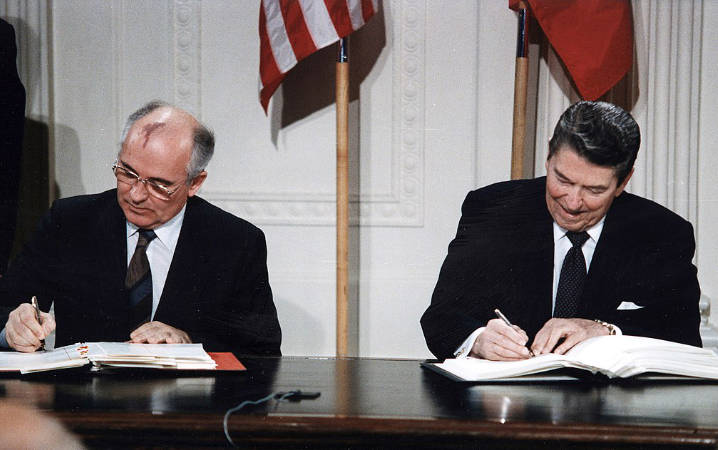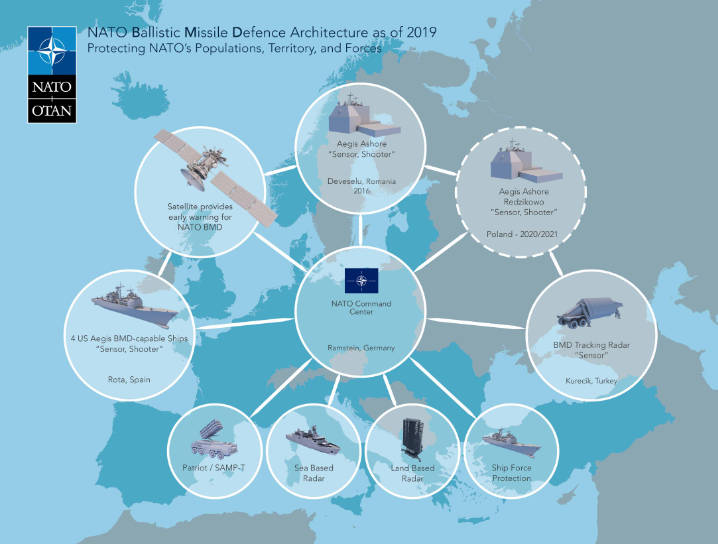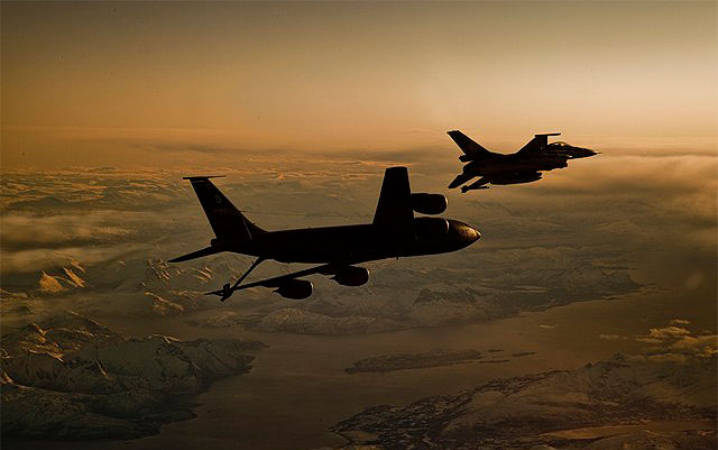Jacek Durkalec of the Center for Global Security Research assesses the implications for European security of the demise of the Intermediate-Range Nuclear Forces Treaty.
The Intermediate-Range Nuclear Forces Treaty, or INF Treaty, was a landmark agreement and a cornerstone of European security. Its signing in 1987 by the United States and the Soviet Union was a harbinger of political “winds of change” in the East-West relationship. Agreement on the Treaty-mandated destruction of almost 2700 Soviet and US ground-launched ballistic and cruise missiles preceded the dissolution of the Soviet Union. The INF Treaty was a part of a series of arms control accords that defined the post-Cold War Euro-Atlantic security architecture. In this context, the requirements for a credible NATO deterrence and defence posture were significantly lowered, allowing NATO Allies and their former adversaries to benefit from a new and peaceful security environment.

US President Ronald Reagan and General Secretary of the Communist Party of the Soviet Union Mikhail Gorbachev sign the landmark Intermediate-Range Nuclear Forces Treaty at the White House, on 8 December 1987. © White House Photographic Office
Therefore, the end of the INF Treaty reflects the radical worsening of European and global security. Its demise cannot be isolated from Russia’s recent aggressive actions, its ambitious military modernisation and its efforts to undermine the post-Cold War European security order. The Treaty ceased to restrain Russian behaviour at a time when NATO was already absorbed with addressing challenges from the East and other strategic directions. The termination of the Treaty is also not isolated from the strategic developments elsewhere in the world, in particular the proliferation of intermediate-range missiles in Asia.
A world without the INF Treaty is not NATO’s choice. The Alliance, however, has no other choice but to address its consequences. The demise of the Treaty brings new military challenges from Russia and therefore new demands on the Allies to maintain NATO’s deterrence and defence posture in a way that is fit for purpose. It also calls for adapting the NATO arms control playbook to the changing geopolitical, strategic and technological realities. To a greater extent than before, European NATO Allies have to assess how security in Europe is affected by the increasingly turbulent security environment in the Asia-Pacific. All of this will create new challenges for Alliance cohesion – a key factor in NATO’s endurance and effectiveness in the post-INF Treaty world.
Challenges from Russia
Only Russia’s decision-makers know their real intentions in violating the INF Treaty. The violation, however, does not seem to have been caused solely by Moscow’s dissatisfaction with the restraints imposed by the Treaty – the elimination of all Soviet and US ground-launched ballistic and cruise missiles with a range between 500 and 5500 km. If this were the case, Russia could have withdrawn from the Treaty in the mid-2000s, before it started to work on any prohibited missile systems.Instead, Russia chose to covertly violate the agreement with the hope of not being detected. Originally, Russia might have regarded the development of the SSC-8/9M729 intermediate-range ground-launched cruise missile as an insurance against the uncertainties of the future, leaving the decision about its production and deployment open. Moscow probably considered the prohibited weapon a political and military “ace card” that could have been taken out of hiding at a time of Russia’s choosing. This would, at least partially, explain the almost decade-long lag between the start of the missile development in the mid-2000s and its actual deployment around 2017.
Russia moved forward with the deployment of the SSC-8/9M729 only after the radical downturn of Russia’s relationship with the West following the illegal annexation of Crimea. A plausible explanation is that the Kremlin concluded that going slow did not offer any benefits and the potential benefits of dividing Allies were increasing, so the time was ripe for moving full steam ahead.
The deployment of the new cruise missile offered Moscow distinct political and military benefits. From a military perspective, these weapons became a valuable complement to other capabilities, increasing the number and the credibility of available strike options. What makes the SSC-8/9M729 missile unique is that, compared with Russia’s other intermediate-range missiles, ground-launched cruise missiles are more capable of avoiding launch detection and tracking during flight, thus striking their distant targets with little or no warning. If Russia wanted to launch a surprise attack on key NATO military and civilian targets, the SSC-8/9M729 would be the best choice, especially compared to the more easily tracked air and sea platforms for land-attack cruise missiles.
As this nuclear-capable cruise missile can reach almost all European capitals, it also provides an option of nuclear intimidation without relying on strategic intercontinental capabilities which can be directed mainly at the United States. In addition, it can hit all the critical airports and seaports of embarkation for Allied reinforcement, as well as other critical infrastructure across NATO territory to deliver a decisive blow with conventional or nuclear payloads.
Politically, the SSC-8/9M729 also is a perfect political weapon, as it and NATO’s reaction to it may revive all the Western fears, dilemmas and traumas that accompanied the 1977-1987 Euro-missile crisis. Moscow likely calculated that NATO would be divided and unable to respond if Russia presented its counter-accusations that the United States was breaching the Treaty; denied the existence of the missile; and, when it was no longer possible to do that, obfuscated its real capabilities, consistent with the Russian disinformation playbook of deny, deflect and distract (Russia’s counter-accusations against the United States regarding drones, missile defence targets, and Aegis Ashore).
The added political and military value of the SSC-8/9M729 missile fits perfectly into Russia’s theory of victory over NATO: either by fracturing NATO solidarity and demonstrating to them that the costs of military confrontation with Russia are not worth the stake (winning “short of war”); or by shocking NATO Allies to surrender, denying them credible war-fighting options in collective defence scenarios (winning in a “short war”).
Russia’s apparent rationales for building INF-violating strike systems have evolved and they may continue to change over time. In the near term, Russia is likely to seek to secure any perceived military advantage that the possession of the SSC-8/9M729 provides. Russia is also likely to try to gain political advantages in the post-INF Treaty environment by dividing the NATO Allies and blaming the United States for all the negative consequences of the Treaty’s demise. This strategy is already evident in President Putin’s threat that, if the United States proceeds with the development of new intermediate-range ground-launched missiles, “Russia will have no option other than to engage in a full-scale effort to develop similar missiles.” The same goals lie behind Russia’s “moratorium” – that is, promising not to deploy INF-range systems to any region unless the United States does so first.
Adapting NATO’s deterrence and defence posture
In responding to the challenges posed by the Russian INF-range capabilities, the Alliance does not have to start from scratch. It can build on its adaptation measures since 2014. These steps alone, however, are insufficient. The expansion of Russia’s long-range strike capabilities, including the deployment of the SSC-8/9M729 missiles, has created gaps in NATO’s overall posture that need to be closed.To close them, NATO does not need to match Russian investments qualitatively or quantitatively. The question for the Alliance is not whether it should invest in new ground-launched missiles in Europe but how best to undermine Russia’s confidence in its strategy of winning “short of war” or in a “short war.” This requires measured, long-term and asymmetric adjustments across the whole spectrum of NATO’s overall mix of capabilities. This is what NATO has already signaled by examining various options, including strengthening conventional capabilities; investing in air and missile defence; ensuring that NATO’s nuclear deterrent remains safe, secure and effective; boosting intelligence, surveillance and reconnaissance efforts; and ramping up exercises. However, the Allies have to take into account the fact that, in the post-INF Treaty world, addressing the challenges posed by Russia may force them to go further than they would prefer to go.
Regarding conventional capabilities, the biggest challenge of the post-INF world for NATO is to ensure its ability to reinforce the most vulnerable Allies during a conflict. This is because Russia’s long-range strike capabilities could impede, delay or prohibit the movement of Allied forces into and across Europe. NATO needs to have credible means, including infrastructure, to transport and deploy follow-on forces to be able to convince Russia that a quick conventional fait accompli in Europe, even initially successful, would not last long. The effective reinforcement option would also strengthen the deterrent message of the NATO Enhanced Forward Presence in Poland and in the Baltic states that any Russian aggression would be an attack against the entire Alliance. NATO has already begun efforts to increase its pool of follow-on forces and to enable them to move rapidly across Alliance territory.
The post-INF Treaty world requires the Alliance to seek new solutions on how to conduct effective operations despite Russia’s anti-access area-denial (A2/AD) capabilities, enhanced with the new intermediate-range ground-launched cruise missiles. The Alliance’s resilience would be crucial to demonstrate to Russia that, even with a surprise attack, it would not achieve its objectives. Effective NATO strategy may also require Alliance investments in long-range strike capabilities. Additional sea-launched and air-launched response capabilities may provide a solution. However, it is plausible that, in the post-INF Treaty world, NATO will have to periodically reassess whether conventional ground-launched missiles would better contribute to security and stability in Europe.

The proliferation of ballistic missiles poses an increasing threat to Allied populations, territory and deployed forces. The Alliance has a responsibility to take this into account as part of its core task of collective defence. However, re-orienting NATO’s territorial ballistic missile defence comprehensively against Russia would not be technically feasible or affordable. Pictured: NATO’s Ballistic Missile Defence architecture as of 2019 © NATO
Russia’s deployment of the SSC-8/9M729 demonstrates the need for the Alliance to defend its critical civilian and military assets against Russia’s cruise missiles. Therefore, augmenting NATO Integrated Air and Missile Defence to address this problem will be an important task. Depending on Moscow’s military investments, NATO may also be forced to seek ways to defend its key assets against a limited attack from Russian intermediate-range ballistic missiles. However, this does not change the fact that defending the whole of NATO territory and populations against all types of Russian missiles will remain beyond the Alliance’s reach. Re-orienting NATO’s territorial ballistic missile defence comprehensively against Russia would not be technically feasible or affordable.
Credible nuclear deterrence will remain the key to deter Russia’s limited use of nuclear weapons or nuclear blackmail. To ensure it, NATO does not need to deploy new ground-launched intermediate-range nuclear-armed missiles in Europe and this is unlikely to change in the foreseeable future. The primary task for the Alliance is to maintain the effectiveness of the nuclear forces it already has at its disposal, in particular the option to deliver US nuclear weapons by NATO dual-capable aircraft. An effective collective nuclear mission capability sends a message to any potential adversary that nuclear coercion against one Ally will meet a response from all of them. The credibility of NATO’s nuclear deterrent will also continue to rest on Russia’s perception that even a limited use of nuclear weapons against any NATO Ally could lead to retaliation by the strategic nuclear forces of the United States, the United Kingdom and France.

Nuclear weapons – including the option to deliver US nuclear weapons by NATO dual-capable aircraft – are a core component of NATO’s overall capabilities for deterrence and defence, alongside conventional and missile defence forces. © NATO
Further improvements in NATO’s intelligence, surveillance and reconnaissance capabilities could significantly strengthen Alliance defences against long-range Russian offensive strike systems. Such capabilities could help NATO to expand its decision-making space in potential crises, reducing the risks of miscalculation and inadvertent escalation. As Russian long-range strike capabilities affect the whole range of Allied capabilities, a constant task for the Alliance will also be to ensure the coherence of its overall deterrence and defence posture. Different types of table-top and live exercises could help Allies to address this challenge.
The future of arms control
The INF Treaty was a remarkable arms control achievement as it led to the elimination of an entire class of Soviet/Russian and US missile systems. If Russia had not violated the Treaty, it would continue to play a valuable role in stabilising the European security environment. However, now that the Treaty is gone, there is no simple way of going back to it. Resurrecting it without significantly updating it seems impossible. The reason for this is that the process that led to the termination of the agreement exposed some of its inherent shortcomings. The Treaty’s loopholes were acceptable as long as there was trust that neither party would take advantage of them. Russia’s covert violation, however, undermined that trust.The United States sought to bring Russia back to INF Treaty compliance for five years, over the course of more than thirty bilateral engagements including two meetings of the Treaty’s Special Verification Commission (SVC). These efforts failed and Russia continues to adamantly deny that the SSC-8/9M729 ground-launched cruise missile has a range over 500 km. Unfortunately, the Treaty Parties agreed to end the very effective verification mechanism after ten years, in 2001, preventing the US from identifying and investigating the Russian violation in a timely, rigorous and Treaty-agreed manner. Russia was not obliged by the INF Treaty to agree on any measures that would allow for verifying and enforcing its compliance. Without Russia’s will to cooperate, the talks within the SVC – the Treaty body intended to “resolve questions relating to compliance” – also failed to find a solution. At the same time, the patience in Washington considering the absolute lack of progress in bilateral consultations also reached a dead-end.
The end of the INF Treaty is not the end of arms control in Europe. NATO remains committed to its dual-track approach to security – an approach that encompasses a deterrence path and a path of dialogue and arms control. Even Russia, which has an extensive track record of undermining arms control agreements (including the Treaty on Conventional Armed Forces in Europe, the Open Skies Treaty and the Vienna Document), may be interested in certain circumstances in a new arms control architecture in Europe which better suits its interests.
What the collapse of the INF Treaty signifies is the end of Russian interest in arms control agreements that are based on recognition of common interests in reducing military risks and in building mutual confidence. In the post-INF Treaty world, NATO will have to learn how to pursue arms control with a Russia which is not interested in maintaining the post-Cold War European security architecture and creates instability and unpredictability to undermine it, and whose current arms control goals are incompatible with NATO’s interests.
As with NATO’s deterrence and defence posture, the Alliance’s arms control policy in the post-INF Treaty environment should be aimed at going directly against Russia’s “theory of victory”. Reflecting the canonical goals of arms control – “reducing the likelihood of war, its scope and violence if it occurs, and the political and economic costs of being prepared for it” – NATO’s focus should be to limit Russian space for destabilising actions and make it harder for Russia to achieve its goals “short of war” and in a “short war”.
Regarding the former, the Alliance should be prepared to counter and reject any arms control offers from Russia that serve no purpose other than to divide NATO Allies, bring legitimacy to aggressive Russian steps, and promote a military balance in Europe that favours Russia. The Allies need to shape the security environment with their own proposals for arms control and confidence-and-security-building measures that would provide evidence of the absence of the feared Russian threats.
Concerning the “short war” risk, NATO arms control proposals should be aimed at constraining Russia’s ability to exploit its military time-distance advantage. To achieve this goal, these proposals should address the sources of Russia’s strength:
1. its regional military superiority in areas close to its borders with NATO territory;
2. its ability to quickly mobilise and move massive numbers of conventional forces across Russia’s vast territory; and
3. its capabilities to deny, disrupt or complicate NATO’s reinforcement options, including with intermediate- and strategic-range strike capabilities.
What seems most desirable is a holistic approach to arms control in which NATO aims to find a “sweet spot” that addresses all three sources of Russia’s military advantages. Yet, an arms control agreement that addresses even one source of Russia’s strength may indirectly affect the remaining two. For example, constraining Russia’s military advantage in local areas close to NATO borders may make it more difficult for Russia to take advantage of its follow-on forces and long-range strike capabilities. While limiting Russia’s options for conducting surprise long-range strikes is desirable in the post-INF Treaty world, denying Russia the benefits of ground-launched intermediate-range missiles may be achieved by arms control agreements related to other types of capabilities.
The world without the INF Treaty requires creativity from NATO to design different arms control options that in distinct ways achieve the same goal of improving European security by constraining Russia’s destabilising options and actions. Experimentation, including wargaming, may help NATO to develop and enhance a number of available arms control options and inform new arms control proposals. Even though the prospects for meaningful arms control appear remote today, NATO’s arms control innovations may, in the longer term, lay the groundwork for agreements that are satisfactory for the Alliance and acceptable to Russia as well.
The “Asia-Pacific factor”
The INF Treaty demonstrates how intertwined are the security arrangements for the Euro-Atlantic and Asia-Pacific regions. It is thanks to Japan’s position that the 1987 INF Treaty eliminated all Soviet and US ground-launched intermediate-range ballistic and cruise missiles. For example, in February 1986, Japanese Prime Minister Nakasone intervened directly in correspondence with President Reagan (declassified by Japan in December 2018) by opposing any arms control proposal that would eliminate the Soviet INF-range missiles in Europe while leaving them in Asia. He insisted on comprehensive geographical limitations that closed a potential loophole in the Treaty, which would have allowed the Soviet Union to quickly redeploy missiles to Europe from Asia, permanently endangering the security of the United States’ allies in the region, including Japan.In 2007, when President Putin publicly suggested that it might be in Russia’s national security interest to withdraw from the INF Treaty, he pointed at the intermediate-range missile inventory of Asian countries, in particular India, Iran, North Korea, Pakistan and South Korea. The unspoken concerns about the long-term military balance with China might have played an even bigger role in Russia’s decision to develop the SSC-8/9M729.
China’s potent arsenal of ground-launched intermediate-range missiles was also a factor in the decision of the United States to withdraw from the INF Treaty. US officials and military officers emphasised the challenges that the Chinese arsenal creates for US extended deterrence in the Asia-Pacific and suggested that ground-based intermediate-range missiles could augment the regional posture of the United States. The importance of the “Asia-Pacific factor,” however, does not in any way change the fact that the main rationale for the United States’ withdrawal from the Treaty was Russia’s noncompliance. Without the Russian violation, the United States would probably have concluded that the political and military benefits in Europe of maintaining the Treaty outweighed any potential costs elsewhere.
In the post-INF Treaty world, interdependencies between the European and Asia-Pacific regions will become even more visible. Any political decision about the deployment of INF systems in Asia by the United States will affect debates on such deployments in Europe and vice versa. The “Asia-Pacific factor” will also play a role in any relevant NATO arms control considerations. The United States’ extended deterrence requirements in the Asia-Pacific will influence its arms control freedom of maneuver in Europe.
NATO Allies as well as the United States’ allies in the Asia-Pacific should also expect that Russia and China will cooperate closely in opposing any steps by the United States intended to negate the perceived value of Moscow’s and Beijing’s intermediate-range capabilities. As did the Soviet Union in the 1980s, these countries will seek to take advantage of the post-INF Treaty world to divide the United States from its regional allies and to drive wedges between the US Euro-Atlantic and Asia-Pacific allies, in particular Australia, Japan and South Korea.
NATO cohesion: the key to success
The process that led the United States to withdraw from the INF Treaty was a test of NATO cohesion. So far, the Alliance has passed this test, even though it was not easy.Since 2014, increasingly strong statements called upon Russia to return to full compliance with the INF Treaty. In December 2018, the Allies fully supported the US assessment that Russia is violating the Treaty. All Allies also supported the subsequent decisions of the United States to suspend its compliance with the Treaty, on 1 February 2019, and to withdraw from it six months later, on 2 August 2019. The Allies also agreed to consider potential measures of adaptation to the world without the Treaty.

Speaking to the press following the withdrawal of the United States from the Intermediate-Range Nuclear Forces Treaty, on 2 August 2019, NATO Secretary General Jens Stoltenberg underlines that all NATO Allies support this decision. © NATO
The post-INF Treaty environment will bring new and possibly even more daunting challenges to NATO cohesion. The Allies will have to continue to re-evaluate their collective assessment of the threats and risks posed by Russia’s intermediate-range systems, in the context of Moscow’s constant efforts to divide them. Keeping NATO’s deterrence and defence posture fit for purpose will be an ongoing task that may require the Allies to take politically difficult decisions. Bringing all Allies on board with new NATO arms control initiatives and strategies will be a demanding task as well. Given the global requirements for US extended deterrence, all NATO Allies also have to take into account that the actions of the United States in Europe will be affected by its security commitments in the Asia-Pacific.
NATO’s cohesion will be the key to the Alliance’s success in the post-INF Treaty world. What provides reason for optimism is that over its 70 years of history, NATO has demonstrated remarkable resilience, a constancy of purpose and an ability to forge consensus despite initial differences among the Allies. This was the case before the INF Treaty was signed and during the 30 years of its implementation. We should not doubt that it will be the case in the post-INF Treaty world as well.

